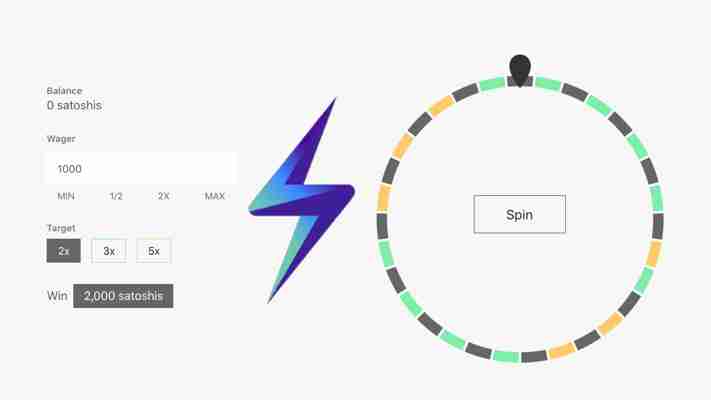Blockchain developers won’t be at peace until every single thing in the world is on blockchain. Or, so it seems.

Web developer Rui Gomes has created Lighting Spin — a web app that lets you play roulette over Bitcoin Lightning Network.
The app lets you wager anywhere between 1,000 Satoshi (approximately 6¢) to 100,000 Satoshi (approximately $6) per round. All you need to play the game is load your balance using a wallet service with support for the Lightning Network – like Eclair, for instance.
You can choose the multiplier you want to wage at. This means that if you wager 1,000 Satoshis with multiplier factor of five — you will win or lose 5,000 Satoshis depending upon the outcome.
If you win, you can withdraw your rewards through Lightning Network as well. But to do this, your wallet service should be able to create invoices. The payments are processed through OpenNode, a Lightning-enabled Bitcoin payment processor for merchants.
Gomes shared a video of the Roulette in action:
The web roulette has been spun more than 7,000 times so far by nearly 300 users at the time of writing. The data on the website shows that more than 4.2 million Satoshis ($248) have been wagered on the game.
For those who do not know, Lightning Network is a payment network that acts as a second layer to Bitcoin’s blockchain to make the transactions cheaper and faster.
The technology is still in a nascent stage but has been successfully tested for micro-transactions across multiple platforms. Developers have been Lightning Network to power payments for fun activities such as an online graffiti board, a Twitch Pokemon game , and a Bitcoin candy dispenser.
However, the payment network is still inefficient for processing transactions worth above a few dollars. A recent study conducted by cryptocurrency research firm Diar showed that the probability of a successful transaction reduces significantly with higher amounts.
If you are into gambling and want to test the Lightning Network, you can play Gomes’ Lightning Spin here.
Disclaimer: Don’t bet with funds you can’t afford to lose!
This archive immortalizes Satoshi Nakamoto’s most memorable Bitcoin quotes
Many have tried and failed to identify the person behind the notorious pseudonym, Satoshi Nakamoto. Shortly after the launch of Bitcoin, Nakamoto vanished form the face of the earth, leaving only a few traces behind.

One of the biggest remnants of Nakamoto’s online existence is an extensive list of forum posts the Bitcoin creator penned while he still worked on the project.
An institute set up to educate the masses about the history and vision of Bitcoin’s creation, the Nakamoto Institute, has indexed every single post Nakamoto ever made – and broken down the list in categories.
Ahead of the 10-year anniversary since the original Bitcoin white paper was released, here are some of our favorites to ponder over:
On the adoption of electronic cash:
Building sound money with code:
Bitcoin is not and never has been anonymous:
The difference between Bitcoin and stocks:
On the benefits of decentralized systems:
For any budding Bitcoin historians out there, this might prove an undeniably useful tool to retrace Nakamoto’s steps through Bitcoin’s seminal years. You can find the full list of Nakamoto quotes here .
Craving more blockchain? Join us at Hard Fork Decentralized, our three-day event in London. We’ll discuss the industry’s future together. You can now register on our website !
Two-thirds of failed stablecoin projects were backed by gold
Stablecoins were once touted by some as a fix for cryptocurrency’s volatility . Thing is, it seems they’re not as stable as their name would suggest. Most of the stablecoin projects announced since 2017 are still yet to launch, and two-thirds of stablecoin projects that have failed were backed by gold.

Since the beginning of 2017, 119 stablecoin projects have been announced and are still yet to be rolled out to the public, there are currently 66 active stablecoins, according to research from blockchain analytcis firm Blockdata .
Credit: Blockdata
To date, 24 stablecoin projects have closed down and ceased operations. Around two-thirds (16) of these now defunct stablecoins were backed by gold reserves.
It seems that question marks over the security of gold reserves have led to this series of stablecoin closures. Blockdata says that fiat-backed stablecoins require a trusted centralized entity (read: bank), which can provide some security. But even then, that’s not always a sure bet – remember the Bitfinex and Tether debacle ?
Gold-backed assets, on the other hand, have to prove that gold exists, and is actually stored somewhere securely.
What’s more, gold itself is not a stable asset, it’s subject to its own volatility, scarcity, and market pressures. In some cases, stockpiling large amouns of the commodity can inflate the price, making the stablecoin it’s supposed to back less stable.
Given the 119 projects that are still in limbo, we could see a raft of new stablecoins in the coming years. On the other hand, we might have to start adding dead stablecoin projects to the crypto-graveyard .











